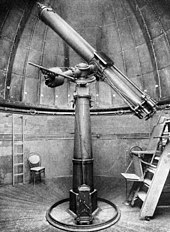Leipzig observatory

A Leipzig observatory existed from 1794 as an institution of the university at two locations in Leipzig one after the other . The first observatory was located on the tower of the medieval Pleißenburg until 1861 . The new observatory in the Johannistal , which opened in the same year, continued to operate in a makeshift manner after being partially destroyed in the heavy air raid on December 4, 1943 , but was finally closed in 1956.
Today there is no longer an astronomical observatory or planetarium in Leipzig . The large planetarium opened in Leipzig Zoo in 1926 was also destroyed by bombs; the planetarium in the zoo , which existed from 1992 to 1996, had to cease operations due to a lack of audience response and summer temperature problems in the dome. Until about 2002 there was next to the Bethanienkirche in Schleußig an observatory used by the adult education center and the Johannes-Kepler-Gymnasium . After its closure and the sale of the property at Stieglitzstrasse 40 by the City of Leipzig, the two closest facilities of this type are the “Juri Gagarin” observatory in Eilenburg , which opened in 1965, and the Schkeuditz Astronomical Center, which has existed since 1978 . Together they form the North Saxony observatory .
history

The old observatory on the Pleißenburg
The first university observatory was built in 1787/1790 through the reconstruction of the Pleißenburg tower based on a design by the Leipzig mathematicians Georg Heinrich Borz (1714–1799) and Carl Friedrich Hindenburg (1741–1808). The classical rotunda of the observatory, inaugurated on February 3, 1794, as the upper end of the castle tower, was designed by the architect and building director of the city of Leipzig, Johann Carl Friedrich Dauthe (1746–1816). However, the foundation of the telescopic pillar did not meet the later requirements.
The observatory was headed by an observer until 1848 , who was supported by (until 1815 two, then only one) assistants ( Amanuensis ). The staff also included an attendant (since 1842: Castellan ). In 1848 the position of assistant was changed to that of a second observer; the previous observator has since acted as director of the observatory.
Observers and directors of the old observatory were:
- 1791–1809: Christian Friedrich Rüdiger (1760–1809)
- 1811–1816: Carl Brandan Mollweide (1774–1825), developed the map projection named after him
- 1816–1848: August Ferdinand Möbius (1790–1868); 1848–1861 director of the observatory
- 1848–1857: Heinrich Louis d'Arrest (1822–1875), co-discoverer of the planet Neptune
- 1860–1861: Karl Christian Bruhns (1830–1881)
In 1861 the observatory was closed after it could no longer fulfill its original purpose due to the dense development and the new observatory in the Johannistal had been opened as a replacement . The Pleißenburg and the old observatory were demolished in 1897 to make room for the New City Hall of Leipzig. The foundations of the old castle tower were used for the construction of the new town hall tower.
The new observatory in Johannistal
As early as 1857 there were plans for a new building. After the city had made the property available to the university on favorable terms, construction began in 1860. The new university observatory in Leipzig was built in 1860/1861 on the western edge of the Johannistal on today's property at Stephanstrasse No. 3 and opened on November 8, 1861. Its architect was Albert Geutebrück (1801–1868).
The house for the director K. C. Bruhns was also built according to the design by Geutebrück. It stood right next to the observatory and was connected to it via a corridor. The two-storey building in the classical style with a tympanum above the central projection was the official residence of the director of the observatory.
In the observatory there was a library and the so-called " meridian room ", which also housed a collection of astronomical instruments. The construction of the dome , which was mounted on spheres and could be rotated in all directions, was remarkable for the time . There was also a telescope with a focal length of 12 feet (approx. 3.5 meters) and an 8- inch lens (approx. 0.19 meters). Along the dome, a platform that was accessible all around served to set up mobile instruments for observing the sky.
In 1866 a second domed structure was added to the complex, and a tower was added in 1886 (in the picture seen from the south, half covered on the left edge of the picture).
Directors of the new observatory were:
- 1861–1881: Karl Christian Bruhns (1830–1881)
- 1882–1919: Heinrich Bruns (1848–1919)
- 1920–1930: Julius Bauschinger (1860–1934)
- 1930–1943: Franz Josef Hopmann (1890–1975)
During the Second World War , the observatory was partially destroyed in the heavy air raid on December 4, 1943 . In 1956 it had to cease operations entirely.
In the reconstructed remnant of the observatory building, the Institute for Meteorology of the Faculty of Physics and Geosciences at the University of Leipzig has been located since 1993 .
literature
- Heinrich Bruns: The University Observatory. In: Festschrift for the 500th anniversary of the University of Leipzig. Volume 4 Part 2, Hirzel Leipzig 1909. (online)
- Birgit Hartung: Albert Geutebrück. Builder of Classicism in Leipzig . Lehmstedt-Verlag, Leipzig 2003, ISBN 3-937146-05-9 , p. 80 f.
- Horst Riedel: Stadtlexikon Leipzig from A to Z . PRO LEIPZIG, Leipzig 2005, ISBN 3-936508-03-8 , p. 573.
- Hans-Joachim Illgauds , Gisela Münzel: The Leipzig University Observatories on the Pleißenburg and in the Johannistal. Astronomical schools of world renown. Sax Verlag, Beucha 1995, ISBN 978-3-930076-11-6 .
Web links
Individual evidence
- ↑ For astronomy fans it looks dark in Leipzig on lvz.de from January 17, 2017



